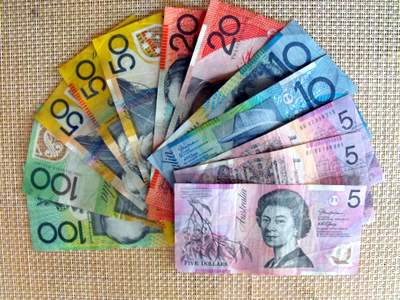Kangaroo buyers spoiled as sale numbers double: Australia credit

By Bloomberg
The number of bond transactions in Australia by overseas-based borrowers almost doubled to 230 as issuers tap investor demand for notes tied to the highest central bank interest rate among major developed nations.
Kangaroo bond issuance surged 48 percent this year to more than A$40 billion ($33 billion), the most on record, as borrowers from Toronto to Seoul thronged to Australia, data compiled by Bloomberg show. Issuers included sovereign-backed lenders such as Germany’s KFW and Landwirtschaftliche Rentenbank, oil companies like Total SA, and commercial banks from as far as Abu Dhabi, Santiago and New York.
Such notes now account for more than a third of syndicated bond sales in Australia as the Reserve Bank’s decision to halt interest-rate cuts helped bring back Japanese investors. Borrowers were lured by the discount they gain from issuing in Aussie dollars as measured by the basis swap used to help determine costs for taking funds raised back home.
“The frequency of deals has picked up and we’ve seen a more diverse issuer base than there was previously,” said Tom Irving, the Singapore-based head of the Asian debt syndicate at TD Securities, this year’s leading manager of Kangaroo sales. “The basis swap has been more constructive for Kangaroo issuers, particularly against euros, especially in the past few months.”
The five-year Australian dollar basis swap, a measure of the discount that overseas issuers receive when they raise funds in the currency and switch back to U.S. dollars, has risen to 29 basis points in Sydney yesterday, from 26 at the end of last year. It reached a two-year high of 34 last month. The equivalent Aussie-euro swap touched 53 basis points on Dec. 8, the highest level since September 2013.
Switching Proceeds
Basis swaps fall when overseas borrowers sell debt in Australia and seek to switch the proceeds into a foreign currency, and rise when Australian issuers do the opposite. Local borrowers have sold the equivalent of more than $81 billion of bonds abroad this year, according to data compiled by Bloomberg.
The Australian dollar bought 81.52 U.S. cents, down 8.6 percent this year, and has advanced 0.6 percent to 65.30 euro cents over the same period. It bought 95.41 yen versus 93.87 at the end of 2013.
TD Securities, a unit of Canada’s Toronto-Dominion Bank, reclaimed its position as the leading arranger for Kangaroo bonds this year, followed by Royal Bank of Canada, which advanced from fifth place. Nomura Holdings Inc. leapt to third from 10th, while Australia & New Zealand Banking Group Ltd. slipped one position to fourth. Deutsche Bank AG, the top sale manager in 2013, fell to fifth in the rankings.
KFW Sales
KFW, a development financier backed by the German government, has sold the most bonds this year, raising A$4.4 billion, while the International Bank for Reconstruction & Development has placed A$2.7 billion of notes.
Debut issuers included Abu Dhabi-based First Gulf Bank PJSC, Banco Santander Chile and Toronto-Dominion, which sold bonds for the first time on its own account after years of being a leading manager of transactions for others. Some have returned after multi-year absences, including the Canadian province of Ontario and Germany’s Landeskreditbank Baden-Wuerttemberg Foerderbank.
Frequent Taps
While total volumes have risen, average sale sizes have dropped as issuers took advantage of investor appetite for smaller, more frequent deals, particularly by top-rated supranational and government issuers selling longer-dated paper.
“There’s been a willingness from some issuers to do smaller taps,” said Oliver Holt, the Hong Kong-based head of the Australian dollar debt syndicate at Nomura. “That’s given sale managers more ability to maneuver, especially with the increase in demand out of Japan for long-dated supranational and sovereign-backed paper.”
He also noted the return of so-called jumbo deals from issuers such as Asian Development Bank and the World Bank, continued supply from U.S. lenders and the emergence of newer borrowers from the Middle East, Latin America and South Korea.
“In 2015 we should see busy issuance from most of the usual borrowers and arguably deals from some new names too,” said Holt. “There are more banks and probably more corporates that could come and take a look at the Australian market in 2015.”
While the currency swap has moved in a favorable direction for Kangaroo issuers, global appetite for yield has helped to compress credit spreads in the Australian market, enhancing the market’s allure. The average yield premium over the swap rate for corporate bonds has shrunk to 92 basis points from 107 on Dec. 31, while the gap for issuers including government-backed and supranational lenders has narrowed 10 basis points to 7, according to Bank of America Merrill Lynch indexes.
“Demand from Japan and Asia more broadly has been busy, Australian domestic accounts have been strong, and with European rates close to zero you’d expect a pickup in participation from European accounts in 2015,” said TD’s Irving. “The bulk of interest is still likely to come from Japan and Asia though.”
Here we are to serve you with news right now. It does not cost much, but worth your attention.
Choose to support open, independent, quality journalism and subscribe on a monthly basis.
By subscribing to our online newspaper, you can have full digital access to all news, analysis, and much more.
You can also follow AzerNEWS on Twitter @AzerNewsAz or Facebook @AzerNewsNewspaper
Thank you!
